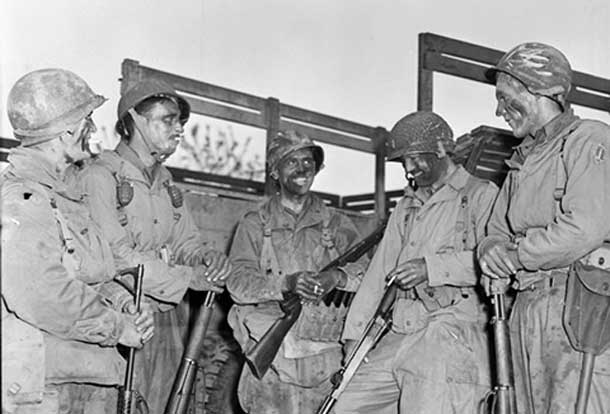
WASHINGTON – Members of the U.S. Congress today presented the Congressional Gold Medal the highest U.S. civilian honor Congress can bestow to the First Special Service Force, made up of U.S. and Canadian troops who participated in the emancipation of Europe and helped end World War II.
Led by House Speaker John Boehner, and joined by other members of Congress, U.S. and Canadian veterans, defense officials, the multinational unit was honored for its demonstrated “fearlessness and bravery” in the Second World War.
“Today’s presentation of the U.S. Congressional Gold Medal to Canadian Veterans of the Devil’s Brigade is a fitting honour in recognition of their courageous service and sacrifice. The impact these remarkable men made during the Second World War has been felt around the world and will never be forgotten,” stated Erin O’Toole, Minister of Veterans Affairs. “I was pleased to meet with Secretary McDonald and Assistant Secretary Schwartz to discuss the mental health and career transition challenges faced by Veterans. To facilitate a successful transition to civilian life it is important that those who have served have access to meaningful employment and mental health supports.”
“We’re here because from all that darkness came an outpouring of grace,” Boehner said. “For these men saved the free world. And now are free to savor the triumph and share their stories for years to come.”
“These men represent the finest of the finest,” he said.
Pioneers and Patriots
Army Gen. Joseph L. Votel, commander of U.S. Special Operations Command, noted the 1,800 soldiers of the “Devil’s Brigade” served as the precursor to modern day U.S. and Canadian special operators.
“Today,” he said, “I represent continuity; I represent those who came behind you.”
“When I think of the Devil’s Brigade two ideas come to mind pioneer and patriot,” Votel said. “I believe it is important to note that these men before you laid the groundwork for both our countries’ modern day Special Forces.”
Earning Its Name
The general explained how the First Special Service Force earned its nickname.
“It was at Anzio where they earned the nickname of the ‘Black Devils,’ Votel said.
The brigade, he said, smeared black boot polish on their faces as they conducted night operations where they fought for 99 straight days without relief, displaying their indomitable spirit and what it means to serve.
“That spirit has carried on to the very descendants of the Devil’s Brigade — the U.S. Army Green Berets and the Canadian Special Operations Regiment,” Votel said. “Both organizations continue to carry the honors won by this highly successful multi-national unit formed during the Second World War.”
Today’s Similarities
The general noted that like today’s special operations forces, the First Special Service Force had many distinct qualities.
“Their members come from all walks of life,” Votel said. “Many were rangers, lumberjacks, north woodsmen, hunters, prospectors and explorers.”
“They were intelligent, athletic, disciplined and well trained,” he said. “They received rigorous instruction in the use of stealth tactics, hand-to-hand combat, parachuting, explosives, demolition and amphibious, and mountain warfare.”
Moreover, Votel added, the unit’s standards were extremely high, as was their esprit de corps, and they were specially selected to tackle the war’s toughest problems.
“They were, indeed, the elite forces of their time,” he said, “and thus, the pioneers of our two nations’ special operations forces.”
“Like our current SOF warriors who have been fighting for these past 14 years,” Votel said, “the members of the Devil’s Brigade were also patriots. They saw a higher calling during a time when their countries and the world needed them most.”
Sincere Gratitude
Votel said many of the troops from the First Special Service Force “made the ultimate sacrifice.”
“For this,” he said, “each and every one of us here today should bestow upon them our sincere gratitude for their amazing contributions and accomplishments on the battlefields in Italy and France some 70 years ago today.”
Votel told the attending members of the First Special Service Force they should be “very proud” not only of their accomplishments, but also for the “foundation and groundwork that you laid to shape our modern day special operations forces, and for the close and professional relationship that ties our two countries together today.”
“Rest assured that your legacy lives on in today’s American and Canadian special operators,” he said.
Votel said without their service and sacrifice, it is “very possible” that Americans and Canadians may not have had the “luxuries of freedom and prosperity that we so fortunately enjoy today.”
“Both of our countries and citizens owe you a boundless debt of gratitude,” he said. “Thank you.”
Quick Facts
- Fourteen Canadian Veterans attended the ceremony, which took place 71 years after the Devil’s Brigade joined the Allied offensive in Anzio, Italy. It was during this battle that the unit was first given their famous nickname.
- In January, 2013, Minister Peter MacKay presented 13 Devil’s Brigade Veterans with the Minister’s Award for Operational Excellence.
- Activated on July 9, 1942, as three small regiments and a service battalion, the Devil’s Brigade was a joint Second World War American-Canadian commando unit trained at Fort William Henry Harrison in Montana, U.S.A.
- The legacy of the brigade lives on, as many modern American and Canadian Special Forces units trace their heritage to this unit.
- Arlington National Cemetery is a U.S. military cemetery located in Arlington, Virginia, across the Potomac River fromWashington, D.C. More than 400,000 active duty service members, Veterans and their families are buried there.
- The Canadian Cross of Sacrifice in Arlington National Cemetery was a gift from the Government of Canada. It stands in memory of American citizens who served with the Canadian Armed Forces and sacrificed their lives during the First World War, the Second World War and the Korean War.
